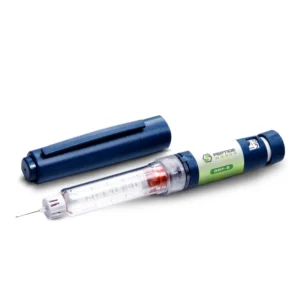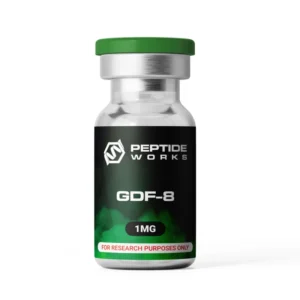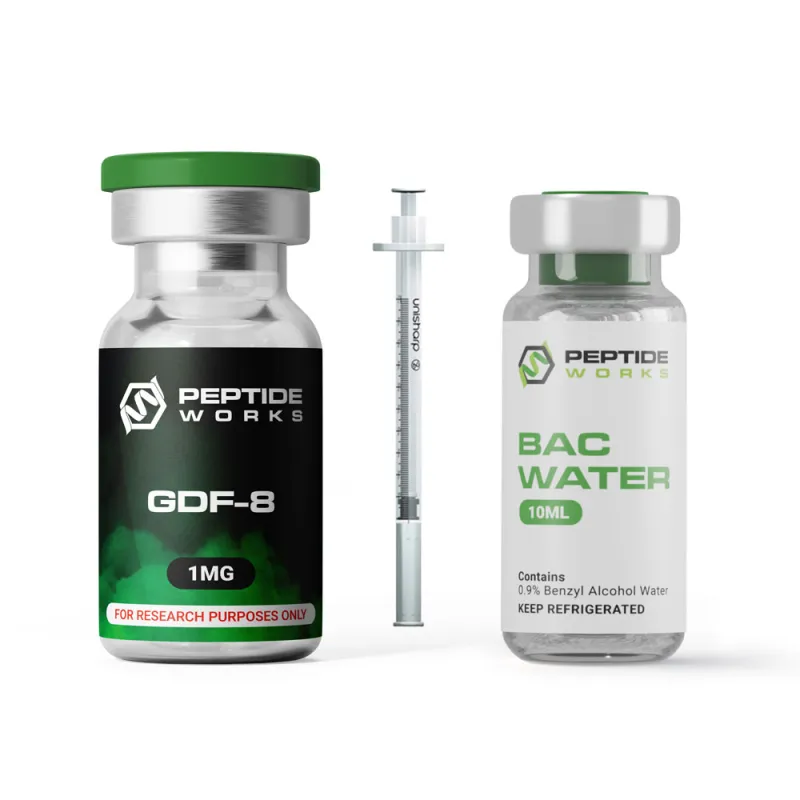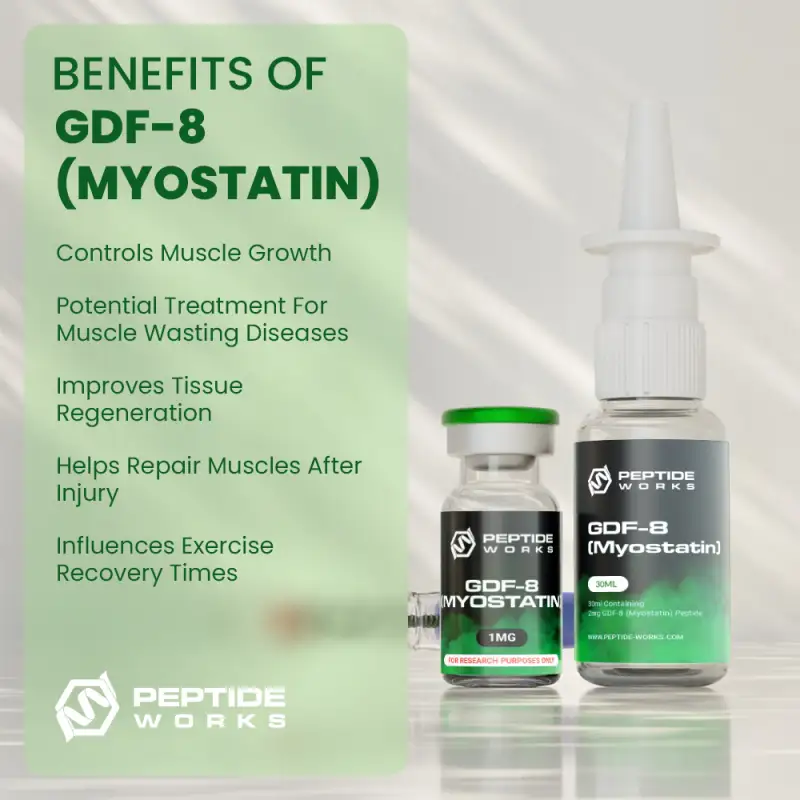PROMO!
First order? Get 10% OFF with this code: 1storder
Our Product Categories



GDF-8, commonly known as Myostatin, is a protein that is a part of the transforming growth factor-beta (TGF-β) superfamily. It is mainly expressed in skeletal muscle tissue and essential in regulating muscle growth and development.
The peptide acts as a negative regulator, meaning it helps to control and limit muscle mass. This protein is of significant interest in research related to muscle disorders, aging, and potential therapeutic applications for enhancing muscle growth in various conditions.
Synonym: Myostatin
View the GDF-8 COA


Growth Differentiation Factor-8 (GDF-8), commonly known as myostatin, is a protein that functions as a powerful negative regulator of skeletal muscle mass. It is produced in skeletal muscle cells and is secreted as an inactive precursor. This precursor becomes active through a process called enzymatic cleavage.
Once activated, myostatin binds to receptors on the surface of muscle cells, specifically the activin type IIB receptor (ActRIIB). When myostatin binds to its receptor, it triggers the SMAD2/3 pathway. This causes a SMAD protein complex to form, which moves into the nucleus and blocks the genes needed for muscle precursor cells (myoblasts) to grow and develop, ultimately limiting muscle growth.
Essentially, myostatin functions as a natural brake on muscle development, ensuring balanced muscle growth and preventing excessive hypertrophy.
Muscle Growth and Regeneration: Research on the GDF-8 peptide has demonstrated that it plays a critical role in regulating muscle growth. It does this by inhibiting muscle mass through activin type IIB receptor signaling [1]. This pathway suppresses myogenesis genes and upregulates atrogenes, contributing to muscle wasting in conditions like cachexia and sarcopenia.
Targeting myostatin signaling has shown promise in preclinical and clinical studies, with inhibitors enhancing muscle mass and function. These therapies hold potential for treating muscle-wasting diseases and improving metabolic health outcomes [2].
Metabolic and Endocrine Health: Research suggests GDF-8 can significantly impact metabolic and endocrine health by regulating muscle mass and insulin sensitivity. Studies have shown that elevated serum myostatin levels are linked to lower insulin sensitivity, contributing to insulin resistance in individuals with overweight/obesity [3].
Additionally, blocking GDF-8 and activin A improves muscle preservation during glucagon-like peptide-1 receptor agonist treatments, enhancing fat loss and metabolic health [4]. These findings highlight the potential of GDF-8 inhibition to improve metabolic outcomes and the quality of weight loss in obesity treatments.
Regenerative Medicine and Stem Cell Research: GDF-8 plays a pivotal role in regenerative medicine and stem cell research by regulating muscle growth and repair. Studies show that inhibiting GDF-8, such as through dual FKRP/FST gene therapy, enhances muscle mass and strength, even surpassing wild-type levels in models of neuromuscular disorders [5]. This approach not only prevents further muscle damage but also rebuilds lost muscle, offering a promising therapeutic strategy for reversing muscular dystrophy and improving patient outcomes.
Agricultural & veterinary applications: Research indicates GDF-8 plays a crucial role in agricultural and veterinary applications by regulating muscle growth in livestock. Studies have shown that MSTN knockout through advanced techniques like CRISPR-Cas9 enhances muscle mass, feed efficiency, and meat quality in animals like cattle, sheep, and poultry [6].
MSTN-edited Hu sheep exhibit double-muscle phenotypes with increased growth rates. Additionally, studies have shown that the combination of MSTN knockout and 3D bioprinting enhances cultivated meat production, providing sustainable protein solutions [7]. These advancements revolutionize breeding and meat production efficiency.
[1] Se-Jin Lee, Shalender Bhasin, Lloyd Klickstein, Venkatesh Krishnan, and Daniel Rooks (2023) Challenges and Future Prospects of Targeting Myostatin/Activin A Signaling to Treat Diseases of Muscle Loss and Metabolic Dysfunction – The Journals of Gerontology: Series A, Volume 78, Issue Supplement_1, June 2023, Pages 32–37.
[2] Y Elkina, S von Haehling, S D Anker, and J Springer (2011) The role of myostatin in muscle wasting: an overview – J Cachexia Sarcopenia Muscle. 2011 Jul 26, Volume 2 (Issue 3), Pages 143–151.
[3] L E Dichtel, A Kimball, B Bollinger, G Scarff, et al (2024) Higher serum myostatin levels are associated with lower insulin sensitivity in adults with overweight/obesity – Physiological Reports. 2024 Sep 11, Volume 12 (Issue 17), Page e16169.
[4] J W. Mastaitis, D Gomez, J G. Raya, D Li, et al (2025) GDF8 and activin A blockade protects against GLP-1–induced muscle loss while enhancing fat loss in obese male mice and non-human primates – Nature Communications, volume 16, Article number: 4377 (2025).
[5] P Lam, D A Zygmunt, Anna Ashbrook, M Bennett, et al (2024) Dual FKRP/FST gene therapy normalizes ambulation, increases strength, decreases pathology, and amplifies gene expression in LGMDR9 mice – Molecular Therapy. 2024 Jun 22, Volume 32 (Issue 8), Pages 2604–2623.
[6] Siti Rani Ayuti, Mirni Lamid, Sunaryo Hadi Warsito, Mohammad Anam Al-Arif, et al (2024) A review of myostatin gene mutations: Enhancing meat production and potential in livestock genetic selection – Open Veterinary Journal, 2024 Dec 31, Volume 14 (Issue 12), Pages 3189–3202.
[7] Rihong Guo, Huili Wang, Chunhua Meng, Hongbing Gui, et al (2023) Efficient and Specific Generation of MSTN-Edited Hu Sheep Using C-CRISPR – Genes (Basel), 2023 Jun 2, Volume 14 (Issue 6), Page 1216.
The answers to the most frequently asked questions about GDF-8 peptide.

Buy GDF-8 Peptide Nasal Spray from Peptide Works. Offered in 15ml and 30ml glass spray bottles, this non-invasive option provides an easy and efficient administration method for research use.
GDF-8, also known as myostatin, helps regulate muscle growth by limiting the amount of muscle the body can build. Some animal studies show that blocking GDF-8 can increase muscle size, but human research is limited and results are not yet proven. GDF-8 peptides are for research use only, not for human consumption.
Yes, GDF-8 and other myostatin inhibitors are banned by the World Anti-Doping Agency (WADA) and most sports organizations. They are classified as performance-enhancing substances. Using or possessing GDF-8 in competitive sports can lead to disqualification and other penalties under anti-doping regulations. It is a research compound and not approved for athletic use.
The U.S. Food and Drug Administration (FDA) has not approved GDF-8 for human use or medical purposes. It is classified as a research compound, intended only for laboratory and scientific studies. Researchers should handle it according to safety guidelines and local regulations, as no FDA evaluation ensures its safety or effectiveness.
Research on GDF-8 peptide remains limited, and its potential effects have not been clearly defined. Some findings from studies on myostatin inhibition mention concerns such as uneven muscle development, joint strain, or circulation-related changes. GDF-8 has not received FDA approval for therapeutic use and is supplied only for regulated research applications.

This blog explains myostatin blocker peptides, research compounds that inhibit myostatin, a protein limiting muscle growth. It explores their mechanisms, such as receptor blocking and SMAD pathway interference, and compares them to alternatives like follistatin. These peptides show promise in muscle research, offering potential applications for muscle-wasting diseases and metabolic health.

This blog explores muscle growth peptides like GDF-8 (Myostatin), MK677, and Follistatin, highlighting their roles in promoting muscle size, repair, and recovery in research. It explains how these peptides work by blocking growth inhibitors, activating satellite cells, and boosting growth hormone, offering insights into muscle development and regeneration studies.

This blog explores the science behind myostatin supplements, research peptides created to block myostatin, a protein that restricts muscle growth. It discusses their role in muscle hypertrophy, the prevention of muscle loss, and their possible use in conditions such as cancer cachexia and muscular dystrophy. Learn how these peptides could shape the future of muscle health research.
ALL CONTENT AND PRODUCT INFORMATION AVAILABLE ON THIS WEBSITE IS FOR EDUCATIONAL PURPOSES ONLY.
DISCLAIMER: These products are intended solely as a research chemical only. This classification allows for their use only for research development and laboratory studies. The information available on our Peptide Works website: https://peptide-works.com/ is provided for educational purposes only. These products are not for human or animal use or consumption in any manner. Handling of these products should be limited to suitably qualified professionals. They are not to be classified as a drug, food, cosmetic, or medicinal product and must not be mislabelled or used as such.